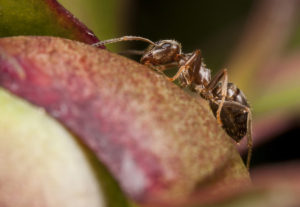 Its name resulted from the mistaken belief of Linnaeus that this ant was one of the plagues of Egypt in the time of the Pharaohs. Pharaoh ants are thought to be native to the African region. This ant is found throughout the United States. Pharaoh ants have been strongly implicated in the spread of various disease pathogens.
Its name resulted from the mistaken belief of Linnaeus that this ant was one of the plagues of Egypt in the time of the Pharaohs. Pharaoh ants are thought to be native to the African region. This ant is found throughout the United States. Pharaoh ants have been strongly implicated in the spread of various disease pathogens.
Workers monomorphic, about 1/16″r(1.5-2.0 mm) long. Body usually pale, varying from yellowish to reddish, with abdomen often darker to blackish. Antenna 12-segmented, with 3—segmented club. Thorax lacks spines, profile unevenly rounded. Pedicel 2-segmented. Stinger present. Queens about 1/8“ (4 mm) long, with/without wings, and slightly darker in color than workers. Male’s about 1/16″ (2 mm), winged, black in color, and antenna straight, not elbowed.
The colonies tend to be large with workers numbering in the thousands to several hundred-thousand. There are usually several hundred reproductive females present in such a colony. Although winged reproductives are produced, there are no flights of swarmers and mating takes place within the nest. New nests can be formed by “budding” with as few as 5 workers, 10 pre-adults, and one queen migrating from the original colony.
These ants are of particular importance in hospitals where they will enter wounds, enter in-use IV bottles, seek moisture from the mouths of sleeping infants, etc. More than a dozen pathogenic bacteria have been found on Pharaoh ants collected in hospitals.
Inside, Pharaoh ants nest in warm (80-86°F/27-30°C), humid (80%) areas near sources of food and/or water. Nests are usually located in inaccessible areas such as wall voids, behind baseboards, in furniture, under floors, and between linens. The workers range widely from the nest in search of food and water, and establish trails to food and water sources. They commonly use electrical and telephone wires as a highway system to travel through walls and between floors. Pharaoh ants are common problems in commercial food handling establishments such as hotels, grocery stores, hospitals, and in apartment complexes.
Outside, these ants seem to be of little importance today. In the temperate/northern areas of the United States, they usually cannot survive outdoors year round; the senior author has observed outdoor overwintering colonies as far north as Raleigh, NC. However, in the subtropical areas such as Florida and Hawaii, it can survive year round outdoors.
They have a wide preference in food, ranging from syrups to fruits, pies, meats, and dead insects. They use carbohydrates primarily for maintenance whereas, protein is primarily required for larval development and egg production by the queens.
Be cautioned that the typical use of liquid or dust pesticides actually makes the situation worse by causing the colony to fracture/bud into several colonies. immediately after such an application, a false sense of control is given during the 7-10 days it takes for the colonies to relocate and reorganize because ants are not seen. Then the ants resume their foraging activity and again become visible. This cycle can be repeated many times.
A thorough initial inspection is crucial to determine ant location(s). Look primarily near moisture sources (potted plants, sinks, etc.) and secondarily near food sources (pet dish, microwave, garbage can, window sills for dead insects, etc.)
Baiting is usually the only method of effective control. Use one bait station per line of ants. Place the station as close to the line of ants as possible without disturbing them.
Pharaoh ants will nest in debris collected on flat roofs and/or those nesting inside will go outside onto flat roots in warm weather for water and food (dead insects). They typically enter/exit via poorly caulked/defective windows, under the flashing, and/or through weep holes.
Beware, you must understand that you must not spray or disturb the ants or the bait stations!
